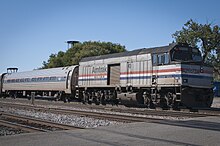Some
commuter rail agencies in the
United States routinely use cab cars in place of regular passenger coaches on trains. However, with commuter agencies such as
Metra, these cars make the train less aerodynamic. The
Chicago and North Western Railway had 42 control cabs built by
Pullman-Standard in 1960, which eliminated the need for its trains or locomotives to be turned around.
[2] It was an outgrowth of multiple-unit operation that was already common on diesel locomotives of the time. The
Réseau de transport métropolitain in
Canada uses control cars on all its trains, except its
electric multiple units, which run as double- ended semipermanently coupled three-car rakes.
During the mid-1990s, as push-pull operations became more common in the United States, cab-cars came under criticism
[3] for providing less protection to engine crews during
level crossing accidents. This has been addressed by providing additional reinforcing in cab cars. This criticism became stronger after the
2005 Glendale train crash, in which a
Metrolink train collided with a
Jeep Grand Cherokee at a level crossing in California. The train was traveling with its cab car in the front, and the train jackknifed.
[4] Eleven people were killed in the accident, and about 180 were injured.
In early 2015,
another collision occurred in
Oxnard, California, involving one of Metrolink's improved "Rotem" cab cars at the front of the train hitting a truck at a crossing. The truck driver left his vehicle before the impact, but the collision resulted in multiple car derailments, jacknifing, injuries, and the death of the engineer.
Converted locomotives[edit]

Amtrak NPCU No. 90368 on the rear of a
Hiawatha Service in 2010
From the 1970s until 1999, the
Long Island Rail Road used a number of older locomotives converted to "power packs". The original prime movers were replaced with 600 horsepower (450 kW) engines/generators solely for supplying HEP with the engineer's
control stand left intact. Locomotives converted included
Alco FA-1s and FA-2s,
EMD F7s and one
F9.
Ontario's
GO Transit had a similar program for
EMD FP7s. MARC had a former F unit, #7100, also converted into a cab car.
Amtrak developed their Non-powered Control Unit (NPCU) by removing the prime mover, main alternator, and traction motors from surplus
F40 locomotives. The
control stand was left in place, as were equipment allowing
horn,
bell and
headlightoperation. A floor and roll-up side-doors were then installed to allow for baggage service, leading to the nickname "cab-baggage cars" or "cabbages". The F40s rebuilt into NPCUs are identified by their former three-digit road number with the number 90 added,
e.g., former locomotive #250 is now NPCU #90250."
[5][
unreliable source?]
Wikimedia Commons has media related to
Cab cars of the United States.
Six NPCUs rebuilt for
Cascades service in the Pacific Northwest (#90250-90253, #90230 and #90340) do not have the roll-up side doors, because the
Talgo sets on which they operate have a baggage car as part of the trainset. Instead, they have a concrete weight for FRA safety reasons. Four NPCUs are used on the
Amtrak Downeaster and are painted with the Downeaster logo on the side instead of the Amtrak logo.






